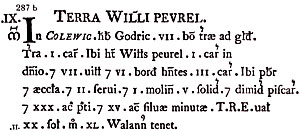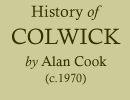< Previous | Contents | Next >
The two villages up to The Domesday Book

Domesday Book entry for Colewic (source: Abraham Farley's edition of Domesday Book, 1783).
The village was in fact two village or settlements, until about the middle of the 12th century, when one was made into a Manor or Park. The area of the old Parish of Colwick which is now inside the Nottingham City boundary was known as Over Colwick, and the remainder was first called Taynes Land or East Colwick, and later Nether Colwick.
Godwin or Godric, tenant of Danegeld, held a manor at Colwick (presumably Over Colwick) before the Conquest, rated at 7 bovates, land for one plough in demesne, 7 villiens and 6 bordars having 3 ploughs. There is a priest and a church, 2 serfs and 1 mill worth 5s., half a fishery, 30 acres of meadow and 15 acres of underwood. Under Godwin, the homestead was contained within a timber enclosure, surrounded by a moat. The buildings also would have been made of timber. This is at the beginning of the 11th century.
At the time of the Domesday Conquest (1086), Over Colwick was held by Waleraun, tenant of William de Peverill. The Domesday Book states, “There was a church there and a water-mill by the Trent side, and attached to the manor were the important rights of a free fishery. More dwelt seven villeins and six bordars in addition to a priest and two serfs or servants.” This means that about 80 people were living there at this time, and it was stated to have been worth 40s. per year at Domesday, but only 20s. in Edward the Confessor’s time.
Nether Colwick at this time was held by Aluric who had three bovates of land and Buga who had two, making five in all. They held this in the King’s name along with two carucates, one sokeman on one bovate, and six villeins and one bordar with two carucates. There was 31 acres of meadow and a small wood of eight acres. Population of this village is also estimated to have been about 80.
Sometime between Waleraun, and the de Colwick family coming into being, the village of Over Colwick disappears and takes the shape of a family estate, with the church belonging to the big house and quite possibly standing inside the moat. It is now listed as one of the “Lost Villages of Nottinghamshire” and classed as a merged or migrated village, and it is quite possible that the villagers were forced to move when the de Colwick’s enclosed the park with hedge and ditch in the 13th century.
